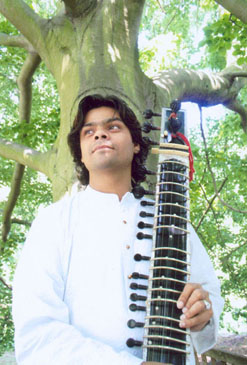The History Of The Sitar
 Among
Indian classical musical instruments, the sitar is perhaps the best
known. What's not known is its exact origin. The sitar has been
in existence for thousands of years in one form or another, but
there are several theories as to who invented it. Most people agree
that the modern sitar first appeared in the 1700s at the end of
the Moghul Empire.
Among
Indian classical musical instruments, the sitar is perhaps the best
known. What's not known is its exact origin. The sitar has been
in existence for thousands of years in one form or another, but
there are several theories as to who invented it. Most people agree
that the modern sitar first appeared in the 1700s at the end of
the Moghul Empire.
There is a popular story that names Amir Khusru, a progenitor of North Indian classical music, as its inventor, but that has been dismissed by serious historians. The other possible theory is that it was modified to combine the Veena and the Persian Sehtar hundreds of years ago. Yet another popular tale names a different Amir Khusru, a descendant of Naugat Khan, as the sitar's creator in the 18th century. Today, most people accept that the sitar originated entirely in India from ancient instruments similar to the Veena.
Whatever its true history, the sitar has continued to evolve over the centuries. Noted musician Masit Khan (the second Amir Krusru's grandson) even had a musical style named after him, the Masitkhani Gat. This style is slow, in the dhrupad style. Raza Khan is the creator of a faster style known as Razakani Gat. Other musicians associated with the sitar include Vilayat Khan, one of the most prominent sitar players of the 20th century, and of course Ravi Shankar, who brought the sitar to Woodstock.
At Sitars Etc., we are more than just a retailer of sitars and other Indian musical instruments and accessories. We are also deeply committed to the history of the sitar and its sister instruments. They represent not only a wonderful musical history, but a cultural one as well. For this reason, it is imperative to us that we preserve this great tradition by dealing in only true sitars, hand-picked by experts from the manufacturers themselves. Keep in mind that all of our sitars are shipped exclusively by air from India, which means they will arrive at your door in superior condition.
 ETYMOLOGY
AND HISTORY
ETYMOLOGY
AND HISTORY
The name sitar comes from the Persian SEHTAAR, Seh meaning three and Taar Mean string. A similar instrument is used to this day in Afghanistan, and the original Persian name is still used. Both instruments are most likely derived from the Turkish tanbur, which is a long, lute-like instrument with no gourd resonating chamber. Both the tembur and Sehtaar were used in pre-Islamic Persia and also used in turkey today. Alternatively, an older Indian instrument called the Rudra veena resembles the sitar in some important respects, most notably in the use of gourd resonators. It is possible that the sitar is actually derived from this instrument.
THE SITAR
Sitar has been India’s most favored Indian Classical String instrument for more than a century. Pandit Ravi Shankar and Ustad Vilayat Khan have made them famous in the West for the 50 years.
The
sitar (Urdu & Hindi, Sitar) is probably the best-known South
Asian instrument in the West. It is a Hindustani classical stringed
instrument which utilizes sympathetic strings along with regular
strings and a gourd resonating chamber to produce a very distinctive
sound. The sitar has been ubiquitous in Hindustani classical music
since the Middle Ages. It became popular in the West when The Beatles
used it in many songs, including "Norwegian Wood (This bird
Has flown):, "Across the Universe", "Love You To",
"Tomorrow Never Knows", and "Within You Without You",
Beatles lead guitarist George Harrison was inspired by, and later
taught by, sitar player Pt. Ravi shankar. Richie Sambora of Bon
Jovi is also a sitar player.
Sitar Players
SITAR
MAESTRO OF THE OLDER GENERATION: USTAD VILAYAT KHAN, PT. RAVI SHANKAR,
PT. NIKHIL BANERJEE, PT. BALRAM PATAK, USTAD IMRAT KHAN, USTAD RAIS
KHAN.
SITAR MAESTRO OF THE YOUNGER GENERATION: USTAD SHAHID PARVEZ, PT.
BUDHADITYA MUKHERJEE, USTAD SHUJAT KHAN, USTAD NISHAT KHAN, USTAD
IRSHAD KHAN.
The Sitar today is still primarily used in the context of North Indian Classical Music, but it’s usage in steadily expanding to include various types of fusion with western classical, jazz, rock, folk, pop, and many other types of music. The sitar was first brought to attention of the western world when George Harrison took it up, under Pt. Ravi Shankar, and began experimenting with it in his work with the Beatles, Subsequently, pioneering musicians such as John MClaughlin, Ustad Zakir Hussain, Colin Walcott, and other first experimented with fusing eastern and western forms of improvisation, thereby laying the groundwork for entirely new world fusion forms.
* Inspiration by : yellowbellmusic.com & en.wikipedia.org/wiki/Sitar
Online Music Store Buy/Order Best SITAR - www.rikhiram.in




